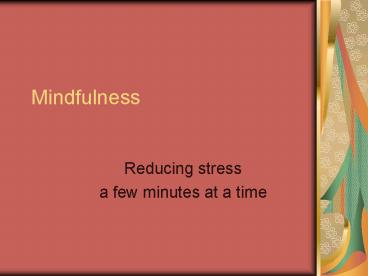Mindfulness PowerPoint PPT Presentation
1 / 19
Title: Mindfulness
1
Mindfulness
- Reducing stress
- a few minutes at a time
2
What in the world.?
- Are we going to do those breathing exercises?
- Is this like relaxation training?
- What ARE we going to do?
3
Why is mindfulness important?
- There is a rapidly growing body of research that
shows many benefits to practicing mindfulness - Improved mental health
- Improved intellectual performance
- Improved physical health
- Improved physical performance
- Faster recovery time from major illness
- Increased productivity with less stress
4
What is mindfulness?
- Mindfulness is the opposite of
- mindlessness, forgetfulness, or
- distraction.
- Mindfulness is a way to calm the mind so it
- will not be overcome by distraction.
- Without distraction, we are free to direct our
- focus, attention, and energy on the present
- moment.
5
More on what mindfulness is
- Mindfulness or being mindful is simply being
aware of your present moment. - You are not judging, reflecting or thinking. You
are simply observing the moment in which you find
yourself. - Mindfulness requires kind attention and
acceptance of yourself.
6
No relaxation training?
Mindfulness is not the same as relaxation.
Sometimes breathing can help us relax or be more
mindful.
Then again, sometimes breathing is just
breathing.
Control is not part of mindfulness. Too much
control leads to distraction.
control
7
How do we lose mindfulness?
- There are so many things that we do over and
over, day after day. - Our mind has limited space and energy. We must
conserve! - We reduce many of these activities to mindless
repetitions in order to conserve space and
energy. - This is necessary and healthy, as long as we
dont overdo it.
8
Pink Elephants
- Im going to give you a very important
instruction. It is essential that you follow it
very strictly. - You will have exactly 60 seconds to carry out
your instruction.
9
No matter what you do, Dont think about Pink
Elephants!
10
What do we learn from this?
- What happens when we try to control our thoughts?
- What happens when we try to control our inner
experiences? - What happens when we give up trying to control
these things and learn to be kind observers of
ourselves?
11
Control disrupts mindfulness
- Mindfulness allows us to open our minds and to
fully receive all that the moment has to offer. - If we are trying to control the moment, we are
busy sending messages and are not able to receive.
12
More on defining mindfulness
- Mindfulness occurs when we do not try to control,
censor, or repress our own experiences. - Mindfulness allows us to accept and make peace
with our own experiences. - When we are mindful, we are more aware, even if
that awareness brings negative thoughts and
emotions.
13
On traditional breathing exercises
- Many people have tried typical breathing
exercises with disappointing results. - Why do they work for some people and not for
others? - CONTROL! Some of us simply try too hard. Trying
to control things so strictly can be stressful.
14
Practice
- Find a natural position in your chair.
- Close your eyes if you wish, or fix your visual
attention on a neutral object. - Notice the sounds in the room. Are they
important, or are they distractions? - Let the distractions fade from awareness.
15
Practice, continued
- Notice your body in the chair. Is the chair
doing the work, or is your body doing the work? - Let the chair do more of the work.
- Notice your breath. Allow your breath to
continue as you notice it. - Appreciate each breath. Know that it comes and
goes.
16
Practice (part 3)
- Notice that each fading breath is replaced by a
new one. - Notice that they vary in length and intensity.
Let each breath reveal its own character. - Continue your kind observations of your own
breath.
17
Practice (part 4)
- Your mind will naturally wander to other things.
This is okay. - Notice or name the thing that your attention
wanders to. - Accept these things and leave them aside,
returning your attention to your breath.
18
Finishing your practice
- Continue this mindful breathing for as long as
you are comfortable. - When you are finished, this is often a good time
to make some decisions about how to proceed with
your day. - This does not mean making a to-do-list! It
simply means coaching yourself in a kind,
accepting way.
19
For further practice
- Five Good Minutes by Brantley Millstine.
Available at most book stores. - This book offers a wide variety of simple
exercises you can do in about 5 minutes. If you
like it, there are other books in the series.

